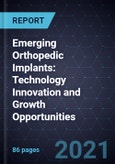Enabling Personalized Orthopedic Care by Leveraging Embedded Sensor and Additive Manufacturing Technologies
Orthopedic implants replace or strengthen a damaged, painful, or deformed bone, cartilage, or joint and restore mobility and flexibility in patients with bone conditions. The demand for orthopedic implants is growing with the increasing number of orthopedic surgeries being performed every year. This is mainly due to the prevalence of musculoskeletal conditions and the expanding aging population (high risk of osteoporosis, low bone mass).
The increased life expectancy, sedentary lifestyles with limited physical activity, and the rising incidence of obesity are also resulting in a growing number of orthopedic problems. Several parameters, including implant design, implant material, fabrication method, and patient compliance, influence the success of implantation surgery. The scientific community is continuously exploring new strategies to minimize the probability of failure of implants and enhance osseointegration for improved implant fixation. Orthopedic implant technology is advancing due to the introduction of new biomaterials that enhance osseointegration, innovative manufacturing technologies that enable customized implants, and embedded sensors that facilitate remote monitoring.
This research service explores various emerging orthopedic implant technologies, their potential impact, and the companies to action. The orthopedic implants industry is assessed in terms of business and technology drivers and restraints. Key funding and acquisition activities over the past 3 years are also investigated. The growth opportunities offered by drug-eluting implant technology, wearables and implantable orthopedic sensors, robotics, and AI and AR have also been discussed. Strategic recommendations for key industry participants are also put forth in the study.








